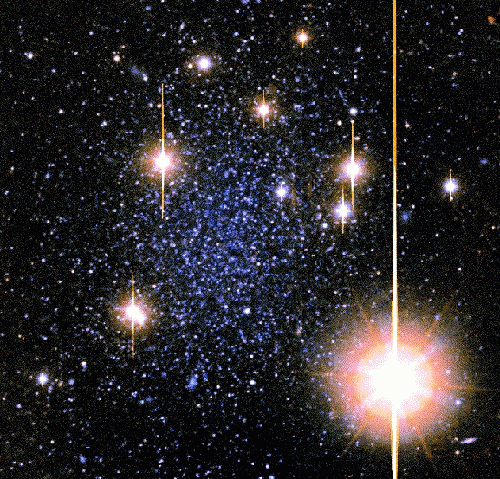A diffuse collection of stars southwest of the Big Dipper’s bowl is a small galaxy revolving around our own, say astronomers in the United States and Europe. The newfound galaxy is roughly 330,000 light-years away — only twice as far as the Large Magellanic Cloud, the Milky Way’s brightest satellite galaxy.
Beth Willman of New York University and her colleagues were searching data from the Sloan Digital Sky Survey when they noticed an excess of stars in the constellation Ursa Major. Then, on March 6, 7, and 8, the astronomers observed this region with the 2.5-meter Isaac Newton Telescope in the Canary Islands.
They find the Ursa Major galaxy is a so-called dwarf spheroidal — a small gas-poor galaxy whose few stars are widely separated from one another. Half of the galaxy’s light comes from a region 1,600 light-years across. This size is typical of dwarf spheroidal galaxies.
Willman’s team reports the new galaxy resembles the Sextans dwarf spheroidal galaxy, another Milky Way satellite. Both the Ursa Major and Sextans galaxies are ancient and have few metals — elements heavier than hydrogen and helium. The astronomers reach this conclusion by plotting the Ursa Major galaxy’s stars on a Hertzsprung-Russell diagram, a graph of stellar color versus brightness.
However, the new galaxy is much less luminous than the Sextans dwarf. It has only about a tenth as many stars. Willman and her colleagues estimate its absolute visual magnitude is roughly –6.75, which means it emits only 1/350,000 as much light as the Milky Way. This makes it the least luminous galaxy ever seen. In fact, some individual stars in the Milky Way, such as Deneb in Cygnus, give off more light than all the stars in the Ursa Major galaxy put together.
If the Ursa Major galaxy had been slightly fainter, Willman and her colleagues say they would have missed it. “Numerous other dwarfs with properties similar to or fainter than the Ursa Major [dwarf spheroidal] may thus exist around the Milky Way,” they write in a paper they have submitted to Astrophysical Journal Letters.
At least twelve other galaxies also orbit the Milky Way. Two are big and bright — the Large and Small Magellanic Clouds — but all the others are obscure: Sculptor and Fornax, discovered in 1938; Leo I and Leo II, discovered in 1950; Draco and Ursa Minor, discovered in 1954; Carina, discovered in 1977; Sextans, discovered in 1990; Sagittarius, discovered in 1994; and Canis Major, discovered in 2003.










